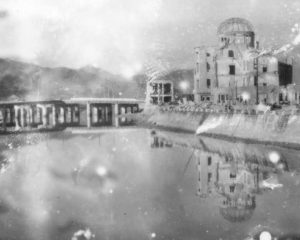Documenting Hiroshima of 1945: September 6, locals still face difficulties one month after atomic bombing
Sep. 6, 2024
by Kyosuke Mizukawa, Senior Staff Writer
On September 6, 1945, the Chugoku Shimbun carried an article in which were conveyed the opinions and stories of three citizens one month after the atomic bombing, under the headline “Mindset of victims.”
The first person, described as “someone living in a provisional shack erected on the burned ruins,” lamented their difficult situation in which there were no prospects to make a living. “Even if people wanted to work, factories are closed. Those who have a job spend their days twiddling their thumbs because there is nothing to do,” the interviewee was quoted in the article. “That is probably the worst thing, because my health is only getting worse.”
Seemingly unaware of radiation damage, that person also revealed how diarrhea had been spreading among people living in the same area of the ruins, surmising it was “probably because of high humidity.” With desperate hope for restoration of electric lighting, the interviewee said, “I only received one candle for the one month since the bombing, making the nights unbearable.”
“Someone living in the half-destroyed house” complained it was difficult to shelter from precipitation and expressed concern about typhoons. The person explained that, “I’m always afraid because my house could collapse at any time.” The third person, who had been labeled “someone who had fled to the suburbs,” reported problems with commuting to work in the Hiroshima City area.
Governmental agencies responsible for leading recovery efforts were also greatly damaged in the bombing. On September 6, the Hiroshima Prefectural government held a memorial service for employee A-bombing victims at Toyo Kogyo in the town of Fuchu-cho, Hiroshima Prefecture, where the government had been relocated after its previous offices were destroyed. By September 7, the prefecture had confirmed the deaths of 606 employees, a number that ultimately rose to 1,141 people.
The idea that “nothing would grow in Hiroshima for 70 years,” which had spread based on comments made by U.S. scientists, cast a shadow on the city’s rebuilding efforts. According to the Chugoku Shimbun published on September 2, 1945, the prefectural government was looking into a plan “to keep the hypocenter area vacant, given that the toxic effects from the atomic bomb would remain for a long period.”
Later, opinions from Japanese specialists and results of surveys were released to refute any idea of biological infertility. On September 6, Hiroshima Prefectural Governor Genshin Takano addressed the issue. “As survey results consistently indicate that persistent damage would largely not remain in the area where the atomic bomb had been dropped, the prefecture must quickly decide on a policy for the city’s future rebuilding.”
(Originally published on September 6, 2024)
On September 6, 1945, the Chugoku Shimbun carried an article in which were conveyed the opinions and stories of three citizens one month after the atomic bombing, under the headline “Mindset of victims.”
The first person, described as “someone living in a provisional shack erected on the burned ruins,” lamented their difficult situation in which there were no prospects to make a living. “Even if people wanted to work, factories are closed. Those who have a job spend their days twiddling their thumbs because there is nothing to do,” the interviewee was quoted in the article. “That is probably the worst thing, because my health is only getting worse.”
Seemingly unaware of radiation damage, that person also revealed how diarrhea had been spreading among people living in the same area of the ruins, surmising it was “probably because of high humidity.” With desperate hope for restoration of electric lighting, the interviewee said, “I only received one candle for the one month since the bombing, making the nights unbearable.”
“Someone living in the half-destroyed house” complained it was difficult to shelter from precipitation and expressed concern about typhoons. The person explained that, “I’m always afraid because my house could collapse at any time.” The third person, who had been labeled “someone who had fled to the suburbs,” reported problems with commuting to work in the Hiroshima City area.
Governmental agencies responsible for leading recovery efforts were also greatly damaged in the bombing. On September 6, the Hiroshima Prefectural government held a memorial service for employee A-bombing victims at Toyo Kogyo in the town of Fuchu-cho, Hiroshima Prefecture, where the government had been relocated after its previous offices were destroyed. By September 7, the prefecture had confirmed the deaths of 606 employees, a number that ultimately rose to 1,141 people.
The idea that “nothing would grow in Hiroshima for 70 years,” which had spread based on comments made by U.S. scientists, cast a shadow on the city’s rebuilding efforts. According to the Chugoku Shimbun published on September 2, 1945, the prefectural government was looking into a plan “to keep the hypocenter area vacant, given that the toxic effects from the atomic bomb would remain for a long period.”
Later, opinions from Japanese specialists and results of surveys were released to refute any idea of biological infertility. On September 6, Hiroshima Prefectural Governor Genshin Takano addressed the issue. “As survey results consistently indicate that persistent damage would largely not remain in the area where the atomic bomb had been dropped, the prefecture must quickly decide on a policy for the city’s future rebuilding.”
(Originally published on September 6, 2024)








